North American Colonies
North and South Carolina | Charles II gave the territory to eight court favorites. They hoped that the territory’s religious and political freedom would attract colonists from other colonies (to avoid financing expeditions from England). This failed. However, a man named Anthony Ashley Cooper convinced his partners to finance migrations from England, so, in 1670, they sent 300 to Carolina (100 survived). The 100 who survived created a settlement and a city in 1690, which became the colonial capital. Cooper had created the Fundamental Constitution for Carolina in 1669, which created a social order. However, there still were problems. The north and southern regions of Carolina were divided; the northern region consisted of isolated farmers practicing sustenance agriculture, while the southern region had a prosperous economy, an aristocracy, and imported African slaves (from Barbados). After Cooper died in 1719, the colonists seized control of the colony. In 1729, Charles II divided Carolina into North and South Carolina. |
New York | In 1664 Charles II granted his brother James, the Duke of York, the territory between the Connecticut and Delaware rivers. However, much of the territory was claimed by the Dutch as a part of New Amsterdam. That year, Englishman Richard Nicolls and his fleet forced the governor of New Amsterdam to surrender. The colony was then given to the British under the assurance that the Dutch wouldn’t be displaced. |
New Jersey | Shortly after receiving his charter, James gave a large portion of the land south of the Hudson River to the Delaware River to Sir John Berkely and Sir George Carteret, Carolina proprietors. In 1702, after a decade of political and economic problems, the two gave control of the territory back to the Crown. |
Pennsylvania | A group called The Society of Friends (the Quakers), an unpopular Protestant group that held beliefs different from much of England, sought asylum in North America. In New England (except Rhode Island), many were fined, beat, and banished. In North Carolina, they became the fastest growing religious community—but some still wanted their own colony. It was hard for them to get a royal grant because they were a despised sect. However, wealthy people became attracted to Quakerism. One in particular, William Penn, with Quaker leader George Fox, had seen Quakers on the European continent who wanted to emigrate to North America; he was interested in helping them out. Penn first looked in New Jersey, and eventually became the owner of part of the colony. In 1681, when his father died, Penn inherited a debt from the king. Charles II, who didn’t have enough cash, granted him a territory between New York and Maryland. Pennsylvania, as it was then named, soon became the most well known colony. In 1682 he supervised the laying out of a city, which he named “Philadelphia”. Penn believed that the land belonged to the native Americans, thus treated it as such. The natives, thus, respected him and the colony had no major conflicts with them. By the late 1690s, some of Pennsylvania’s residents began to resist Penn’s absolute power. So, in 1701, before he departed to England, he agreed to a Charter of Liberties, which established a representative assembly. Though the colony itself was prosperous, the colony never made profits for Penn and his descendants. Thus, Penn was imprisoned in England for debt and died in poverty in 1718. |
Delaware | The Charter of Liberties agreed upon by William Penn, proprietor of Pennsylvania, granter three “lower counties” to establish their own representative assembly. They did so in 1703 and, thus, became a separate colony: Delaware. It was under the governor of Pennsylvania until the American Revolution. |
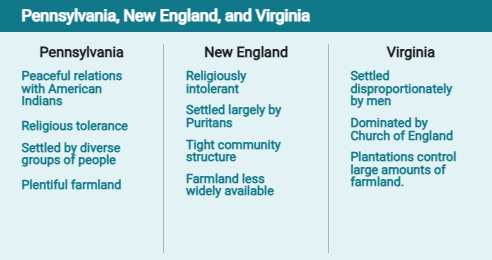
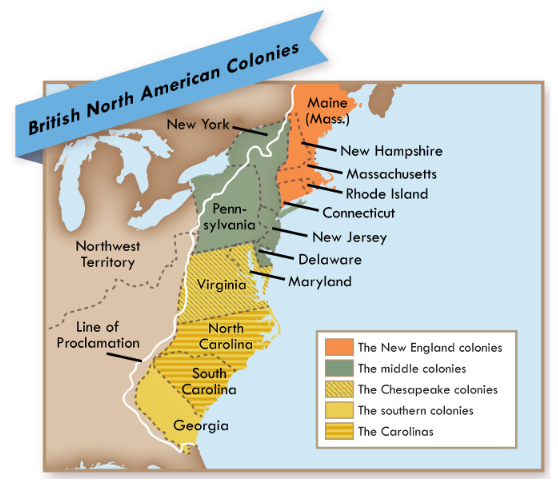
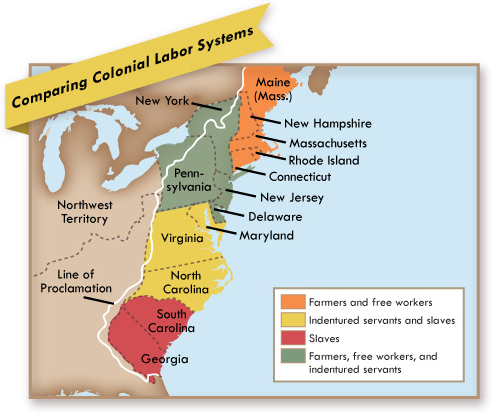
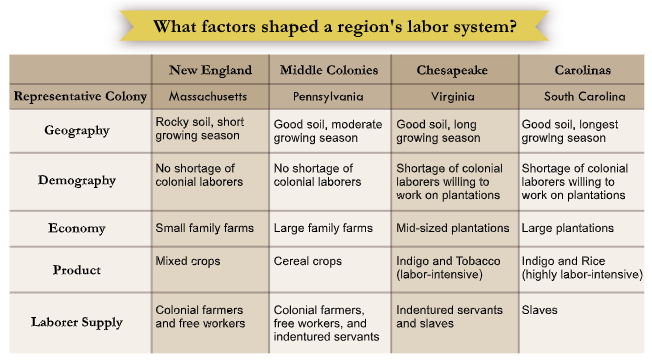
Triangular Trade
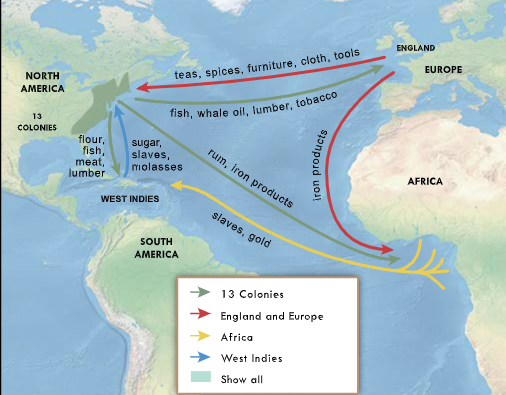
The New England colonies: Massachusetts, Rhode Island, New Hampshire, Maine, and Connecticut
The middle colonies: New York, New Jersey, Pennsylvania, and Delaware
The Chesapeake colonies: Virginia and Maryland
The southern colonies: Virginia, Maryland, North Carolina, South Carolina, and Georgia
The Carolinas: North Carolina and South Carolina
More Notes
Adapted from Brinkley, Alan. 2014. American History: Connecting With the Past, AP Edition. E-book. 15th ed. McGraw-Hill Education. Pages 49–53
Images and additional information from Apex Learning.